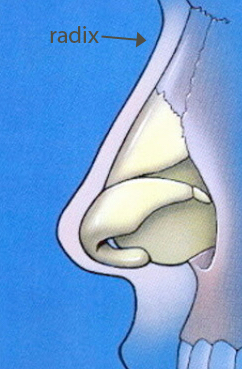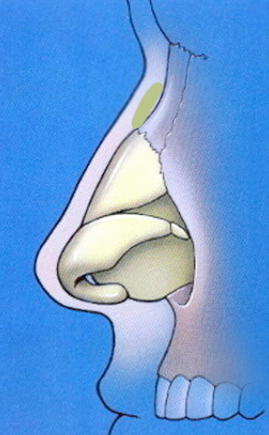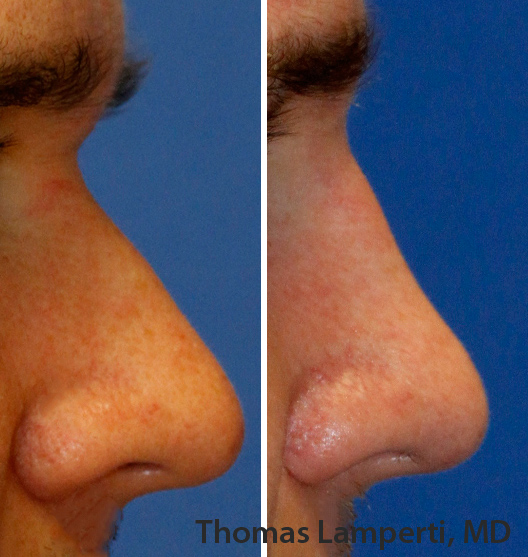Low Radix Augmentation
Low Radix
See how nasal pseudo-hump reduction from the bridge is achieved with radix grafting to create a more natural appearing rhinoplasty result.
One of the most common things done during rhinoplasty surgery is taking down a dorsal hump or bump from the bridge. One variation of this problem that creates the illusion of a large bump is what's called a low radix or pseudo-hump.
What is the radix?
Before discussing what a pseudo-hump is we need to outline what the radix is. The radix is the upper part of the nose that falls where the bridge meets the forehead (just below the area between the eyebrows). The schematic below shows where the radix is:

Ideally the radix starts at a level (as seen on profile view) roughly between the eye lashes or upper eyelid supra-tarsal crease.
What is a pseudo-hump?
A pseudo-hump refers to a nose in which the radix is under-developed and under-projecting. This leads to a profile in which the tissue below the radix (toward the tip) appears even fuller than it really is. This schematic shows how a pseudo-hump is created when the bone of the radix doesn't project the overlying soft tissue adequately.

How do you treat an underdeveloped, low radix?
An under-projecting radix is best treated during rhinoplasty with radix tissue grafting. A radix graft can be composed of cartilage, fascia, or other soft tissue. It is most commonly composed of a carved piece of cartilage (often from the septum) that is placed below the skin and muscle of the nose of the radix where it is camouflaged very nicely. This schematic illustrates how the bony deficit is counter-acted by placing the cartilage graft over the bone where it lifts the depressed soft tissue. The result is a much straighter profile without needing to remove any bone or cartilage below the radix.

Proper management of the radix is vital in creating a natural, un-operated appearing nose.
Can you have weak radix and a true hump?
You can have both an under-developed radix and a true hump. The benefit of addressing both is that more conservative hump removal can be done.
As the radix position is elevated the ideal profile line is brought closer to the hump. As a result less of the hump has to be removed to create the proper profile. This approach also has the advantage in that the nose appears less operated on or "surgical" thanks to the stronger nasal starting point.
Before and after Radix Grafting Photos
Here are some before and after examples of what radix grafting can achieve:
This patient had a combination of hump reduction and radix grafting with a portion of carved septal cartilage.

This before and after photo montage shows the natural result that this method of radix weakness and dorsal hump treatment can create.

You can see how in the patient below her radix is low and starts at the level of her pupils.

With an improved, stronger profile the patient maintains a natural, yet refined profile in which we're able to maintain the patient's ethnic identity.
This male patient also has a weak radix along with a prominent nasal bump. Similar to the patients above, Dr. Lamperti both took down the hump and strengthened the low radix with a septal cartilage graft.

Here's another patient who had a radix graft placed. His was done using a closed rhinoplasty approach. Click on the photo to read more about this patient's surgery.

Meet Plastic Surgeon, Dr. Lamperti
Dr. Lamperti, a Seattle rhinoplasty super-specialist, has devoted his career to treatments of the head, face and neck. He feels that by focusing his plastic surgery endeavors solely to the face he is best able to provide the excellent results his patients desire.
Interested in learning more about having a Rhinoplasty Treatment in Seattle with Dr. Lamperti?
Contact us to have a private consultation or view Before & After photos here.
